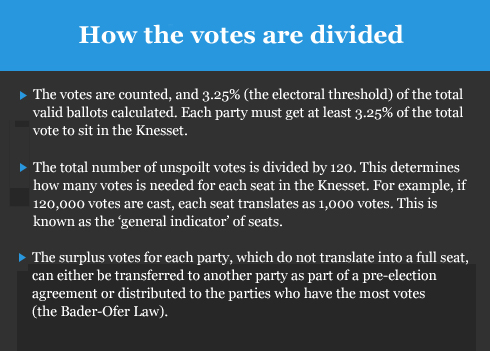
How the votes will become seats
After the polls close, the votes are counted and the distribution of seats begins -- including the complex calculations to assign surplus votes.
After the polling stations close at 10 PM on Wednesday, the Central Elections Committee will begin the work of translating votes into seats. The system for this can be complex. This is how it works.
The first stage occurs shortly after the polling stations close, when the committee begins to count votes – that is, counting the number of ballots submitted around the country and removing invalid votes.
The committee will also count envelopes that contain more than one voting slip, which are disqualified, after which it calculates how many votes are required to pass the election threshold, meaning the number of votes needed for a party to receive seats in the 20th Knesset. The election threshold has been significantly increased in the current elections, standing at 3.25 percent versus 2 percent in the last elections in 2013.
Then parties that did not pass the election threshold are eliminated and their votes are essentially erased and not included in the vote count.
The distribution of seats begins in the second stage. The total number of valid votes that each party that is eligible for seats is divided by 120, the number of seats in the Knesset. The resulting figure is the number of votes equaling one seat and is known as "the general indicator".
The number of valid votes for each party is then divided by the general indicator to determine the number of seats received by each party. The whole numbers that result from this are the seats.
The system becomes somewhat more complicated at this stage, because there are also fractions of seats resulting from the division, meaning there are less than 120 seats. The remaining seats are known as "surplus votes".
The surplus votes are allocated based on a calculation called the Bader-Ofer method and the vote-sharing agreements signed by the parties before elections. In the current elections such agreements were signed between the Zionist Union and Meretz, between United Torah Judaism and Shas, between Bayit Yehudi and Likud, and between Kulanu and Yisrael Beytenu.
The Bader-Ofer method is named after former Knesset members Yohanan Bader and Avraham Ofer, who created it in 1973. It is used to calculate the distribution of surplus votes.
The method takes into consideration the relative size of the parties, including their surplus votes and their vote-sharing agreements.
According to the method, two Knesset lists that signed vote-sharing agreements are considered one party. The number of valid votes for each party are then combined and divided by the number of seats they both received in the initial distribution of seats. One additional seat is then added to the resulting number. The product of this addition is known as the "list indicator".
The list that receives the largest list indicator receives the first surplus vote, and the calculation continues until all surplus votes have been distributed. Every time a list receives an extra seat, the calculation is updated according to the new distribution of seats.












